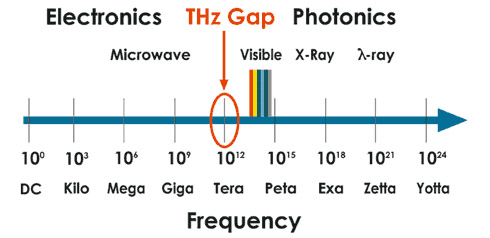Principles of Terahertz science and technology – lecture notes
 Terahertz technology is still a relatively new subject to many of our potential customers, which is the primary reason for starting this introductory series of articles.
Terahertz technology is still a relatively new subject to many of our potential customers, which is the primary reason for starting this introductory series of articles.
TeraSense technology is based on electromagnetic radiation confined to the so-called “THz gap” – a frequency spectrum from 0.1 to 10 THz. In much the same way as visible light is used to create a photograph, terahertz waves (also called T-rays) can be utilized to produce images and to transmit information. Although these concepts have existed in theory for a long time, their practical realization has been hindered by the lack of efficient and affordable THz radiation sources and detectors. However, the situation has been drastically improved over the last few years since TeraSense introduced its innovative low-cost compact THz wave sources and THz imaging cameras.
Today THz technology is widely gaining in popularity for the following reasons:
- Unlike X-rays, THz waves have low photon energy and thus cannot cause photoionization in biological tissue. As a result, THz radiation is considered safe for the human body. What is more, due to high absorption coefficient of water, THz waves cannot penetrate into the human body nearly as far as microwaves can. These properties of T-rays can be used in remote security screening to enable continuous covert surveillance. For this very purpose TeraSense has developed its new security body scanner 2.0, which is currently unique on the market of security screening technologies.
- THz waves have longer wavelengths than those from the IR and the visible spectra. Hence, most dry dielectric materials, such as cloth, paper, wood, ceramic and plastic are transparent to the THz radiation. Furthermore, some dry food products, such as cookies, cereals, seeds, nuts, etc., also have low absorption of T-rays. These factors render THz technology very promising for applications related to nondestructive product quality control and evaluation. In this regard, the operational wavelength is sufficiently short to achieve submillimeter-level spatial resolution.
- At THz frequencies, many molecules exhibit characteristic absorption and dispersion which enables their spectroscopic fingerprinting in the THz range. Thus, in combination with imaging technology, nondestructive inspection using THz waves can provide both target profile and its composition information.
At the same time, however, THz technology has some limitations connected with the nature of terahertz waves. Firstly, as it has already been mentioned, the spatial resolution in THz imaging depends on the operating wavelength and can approach figures from 3 mm at 100 GHz to 0.3 mm at 1THz. Secondly, absorption of THz radiation by almost all materials increases with frequency, for example, clothes are absolutely transparent at 100 GHz, but totally opaque at 800 GHz. Finally, all metals, stone, carbon and water are highly reflective at THz frequencies. Most critically important of these, of course, is water. As humidity is always present in porous materials, such as natural fiber, paper, sand, brick, mortar, food, etc., their transparency to THz waves strongly depends on humidity level. Therefore, due to such obvious practical constraints THz technology is not suitable for detection of objects:
- Underground
- Underwater
- Inside human body
Differential transparency of various materials to T-rays is the main criteria that allows for detection of anomalies and defects in nondestructive tests, biological tests and security screening. However, these subjects are to be covered in our future articles…